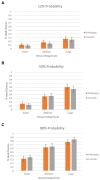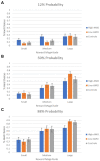Effort-based decision making in schizotypy and its relationship with amotivation and psychosocial functioning
- PMID: 36873206
- PMCID: PMC9978481
- DOI: 10.3389/fpsyt.2023.1123046
Effort-based decision making in schizotypy and its relationship with amotivation and psychosocial functioning
Abstract
Introduction: Suboptimal effort-based decision-making with reduced willingness to expend effort for high-probability/high-value reward is observed in schizophrenia patients and is related to diminished motivation, but is understudied in schizotypy. This study aimed to examine effort-allocation in schizotypy individuals and its association with amotivation and psychosocial functioning.
Methods: We recruited 40 schizotypy individuals and 40 demographically-matched healthy controls, based on Schizotypal Personality Questionnaire-Brief (SPQ-B) score (top and bottom 10% SPQ-B scores, respectively), from 2400 young people aged 15-24 years participating a population-based mental health survey in Hong Kong and examined effort-allocation using the Effort Expenditure for Reward Task (EEfRT). Negative / amotivation symptoms and psychosocial functioning were assessed by the Brief Negative Symptom Scale (BNSS) and the Social Functioning and Occupational Assessment Scale (SOFAS), respectively. Schizotypy individuals were categorized into high-amotivation and low-amotivation groups based on a median-split of BNSS amotivation domain score.
Results: Our results showed no main group effect (in either two or three-group comparison) on effort task performance. Three-group comparison analyses on selected EEfRT performance indices revealed that high-amotivation schizotypy individuals displayed significantly less increase in effortful options from low-value to high-value reward (reward-difference score) and from low-probability/low-value to high-probability/high-value reward (probability/reward-difference score) than low-amotivation individuals and controls. Correlation analyses demonstrated trend-wise significance between BNSS amotivation domain score and several EEfRT performance indices in schizotypy group. Schizotypy individuals with poorer psychosocial functioning tended to exhibit smaller probability/reward-difference score relative to other two groups.
Discussion: Our findings indicate subtle effort-allocation abnormalities in schizotypy individuals with high levels of diminished motivation, and suggest the link between laboratory-based effort-cost measures and real-world functional outcome.
Keywords: Effort-based decision-making; amotivation; effort allocation; psychosocial functioning; schizotypy.
Copyright © 2023 Chu, Tong, Wong, Chang, Tang, Chan, Lui, Hui, Suen, Chan, Lee and Chen EYH.
Conflict of interest statement
The authors declare that the research was conducted in the absence of any commercial or financial relationships that could be construed as a potential conflict of interest.
Figures


Similar articles
-
Effort-based decision-making impairment in patients with clinically-stabilized first-episode psychosis and its relationship with amotivation and psychosocial functioning.Eur Neuropsychopharmacol. 2019 May;29(5):629-642. doi: 10.1016/j.euroneuro.2019.03.006. Epub 2019 Mar 15. Eur Neuropsychopharmacol. 2019. PMID: 30879927
-
Abnormal cognitive effort allocation and its association with amotivation in first-episode psychosis.Psychol Med. 2020 Nov;50(15):2599-2609. doi: 10.1017/S0033291719002769. Epub 2019 Oct 2. Psychol Med. 2020. PMID: 31576787
-
Motivation and effort in individuals with social anhedonia.Schizophr Res. 2015 Jun;165(1):70-5. doi: 10.1016/j.schres.2015.03.030. Epub 2015 Apr 15. Schizophr Res. 2015. PMID: 25888337 Free PMC article.
-
Translational Rodent Paradigms to Investigate Neuromechanisms Underlying Behaviors Relevant to Amotivation and Altered Reward Processing in Schizophrenia.Schizophr Bull. 2015 Sep;41(5):1024-34. doi: 10.1093/schbul/sbv093. Epub 2015 Jul 20. Schizophr Bull. 2015. PMID: 26194891 Free PMC article. Review.
-
A reference-based theory of motivation and effort allocation.Psychon Bull Rev. 2022 Dec;29(6):2070-2082. doi: 10.3758/s13423-022-02135-8. Epub 2022 Jun 29. Psychon Bull Rev. 2022. PMID: 35768658 Free PMC article. Review.
Cited by
-
Anhedonia Across and Beyond the Schizophrenia Spectrum.Schizophr Bull. 2025 Mar 14;51(2):293-308. doi: 10.1093/schbul/sbae165. Schizophr Bull. 2025. PMID: 39326030 Free PMC article. Review.
-
Association between ADHD symptoms, physical effort discounting, and unhealthy lifestyles in adults.Sci Rep. 2025 May 18;15(1):17255. doi: 10.1038/s41598-025-02024-9. Sci Rep. 2025. PMID: 40383835 Free PMC article.
References
-
- Meehl PE. Toward an integrated theory of schizotaxia, schizotypy, and schizophrenia. J Pers Disord. (1990) 4:1–99. doi: 10.1521/pedi.1990.4.1.1 - DOI
-
- Claridge G, Beech T. Fully and quasi-dimensional constructions of schizotypy In: Raine A, Lencz T, editors. Schizotypal Personality Disorder. Cambridge: Cambridge University Press; (1995). 192–216.
LinkOut - more resources
Full Text Sources

